Geography Playlist
19 chapters • 0 completed
The Universe and the Earth
18 topics
Atmosphere and its composition
6 topics
Atmospheric Temperature
11 topics
Atmospheric Moisture
9 topics
Air Mass, Fronts & Cyclones
15 topics
Evolution of Earths Crust, Earthquakes and Volcanoes
23 topics
Interior of The Earth
14 topics
Landforms
25 topics
Geomorphic Processes
10 topics
Movement of Ocean Water
16 topics
Oceans and its Properties
12 topics
Climate of a Region
14 topics
Indian Geography - introduction, Geology
5 topics
Physiography of India
27 topics
Indian Climate
20 topics
Indian Drainage
32 topics
Soil and Natural Vegetation
13 topics
Mineral and Energy Resources, Industries in India
28 topics
Indian Agriculture
22 topics
Chapter 15: Indian Climate
Chapter TestIndian Climate – Features of Monsoon
India has a tropical monsoon climate, marked by seasonal reversal of winds, wet and dry seasons, and heavy dependence of agriculture and economy on monsoon rains.
India has a tropical monsoon climate, marked by seasonal reversal of winds, wet and dry seasons, and heavy dependence of agriculture and economy on monsoon rains.
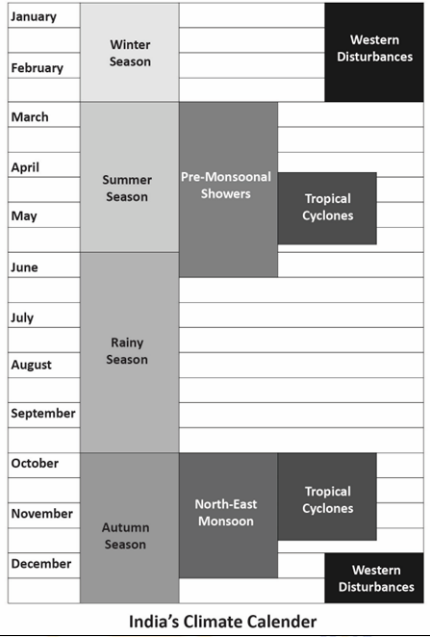
Key Features of Monsoon Climate
| Feature | Description |
|---|---|
| Climate Type | Tropical monsoon with wet & dry seasons |
| Wind Reversal | Onshore (summer rains) vs Offshore (winter dry) |
| Basis | Modified trade winds |
| Regions | South & Southeast Asia, N. Australia, E. Africa, W. Africa |
| India | Agriculture, economy, and society heavily dependent |
Mains Key Points
Prelims Strategy Tips
Salient Features of Indian Climate
Indian climate is governed by monsoons, marked by reversal of winds, seasonal variability, unity despite diversity, and proneness to natural calamities.
Indian climate is governed by monsoons, marked by reversal of winds, seasonal variability, unity despite diversity, and proneness to natural calamities.
Salient Features of Indian Climate
| Feature | Description |
|---|---|
| Wind Reversal | NE trade winds in winter; SW monsoon winds in summer |
| Pressure Zones | Seasonal high-low pressure shifts over land & ocean |
| Rainfall | 80% annual rainfall in 4 months (SW monsoon) |
| Seasons | Broadly five; main three – Summer, Winter, Monsoon |
| Unity | Overall tropical; Himalayas shield from cold winds |
| Diversity | Temp: -45°C (Leh) to 55°C (Rajasthan); varied rainfall & humidity |
| Calamities | Floods, droughts, famines, epidemics due to variability |
Mains Key Points
Prelims Strategy Tips
Factors Determining India’s Climate
India’s climate is influenced by its latitudinal extent, the Himalayas, land-ocean distribution, distance from sea, altitude, and relief features.
India’s climate is influenced by its latitudinal extent, the Himalayas, land-ocean distribution, distance from sea, altitude, and relief features.
Factors Influencing India’s Climate
| Factor | Impact |
|---|---|
| Latitude | North → sub-tropical extremes; South → tropical uniformity |
| Himalayas | Block icy winds; ensure tropical conditions |
| Land-Water Distribution | Monsoon mechanism due to differential heating |
| Distance from Sea | Coastal = equable climate; Interior = extremes |
| Altitude | Higher altitudes = cooler climates |
| Relief | Windward = heavy rainfall; Leeward = dry conditions |
Mains Key Points
Prelims Strategy Tips
Climatic Regions of India – Köppen’s Classification
India shows a monsoon type of climate but due to regional variations, Köppen classified India into multiple climatic regions based on temperature and rainfall.
India shows a monsoon type of climate but due to regional variations, Köppen classified India into multiple climatic regions based on temperature and rainfall.
Köppen’s Climatic Regions of India
| Type | Features | Regions |
|---|---|---|
| Aw (Savanna) | Hot summers (~40°C), winter >18°C, monsoon rains | Jharkhand, Odisha, Maharashtra, AP |
| Amw (Monsoon) | Short dry winter, evergreen forests | Konkan, Malabar, Mizoram, Tripura |
| As (Moist) | Annual temp ~18°C, rainfall 75–100 cm | Coromandel Coast |
| BShw (Steppe) | Semi-arid, >18°C, summer rains | E. Rajasthan, TN rain-shadow, Gujarat |
| BWhw (Desert) | Rain <25 cm, hot summers, cold winters | Thar Desert (W. Aravallis) |
| Cwg (Mesothermal) | Dry winter, hot summer | Gangetic Plains |
| Dfc (Cold Humid) | Cold winters, short summers | Sikkim, Arunachal (hills) |
| E (Polar) | Warmest month <10°C | High reaches of J&K, HP, Uttarakhand |
| ET (Tundra) | Warmest month 0–10°C | Kashmir, Ladakh, HP, Uttarakhand |
Mains Key Points
Prelims Strategy Tips
Indian Climatic Calendar
The Indian Meteorological Department (IMD) divides the year into four main seasons: Winter, Summer, Southwest Monsoon, and Autumn (Retreating Monsoon).
The Indian Meteorological Department (IMD) divides the year into four main seasons: Winter, Summer, Southwest Monsoon, and Autumn (Retreating Monsoon).
IMD Seasonal Calendar of India
| Season | Months | Key Features |
|---|---|---|
| Winter | Jan–Feb | Cold & dry; NE trades; Western Disturbances bring rain/snow |
| Summer | Mar–May | Hot & dry; Loo winds; Kalbaisakhi & Mango showers |
| SW Monsoon | Jun–Sep | Main rainy season; ~80% rainfall; Arabian & Bay branches |
| Autumn (Retreating Monsoon) | Oct–Dec | Withdrawal of SW monsoon; NE monsoon rains Tamil Nadu; cyclones |
Mains Key Points
Prelims Strategy Tips
The Winter Season in India
Winter in India spans from mid-November to February, with December–January being the coldest months. Controlled by NE trade winds, high pressure in NW India, and western disturbances, it has distinct north–south variations.
Winter in India spans from mid-November to February, with December–January being the coldest months. Controlled by NE trade winds, high pressure in NW India, and western disturbances, it has distinct north–south variations.
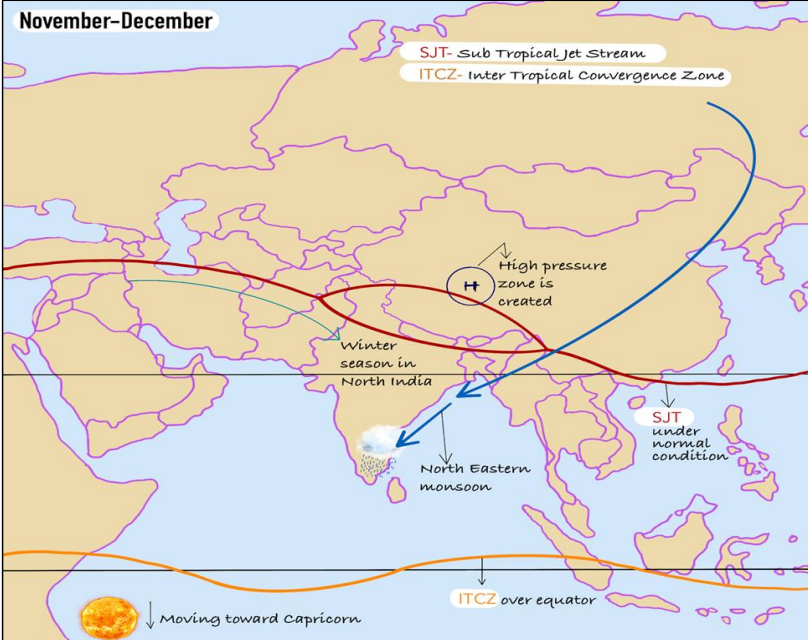
Winter Season in India – Key Facts
| Aspect | Details |
|---|---|
| Duration | Mid-November to February; Dec–Jan coldest |
| Temperature | South India ~20–30°C; NW India ~5°C; Dras -45°C (record) |
| Pressure | High over NW India; low over South India |
| Winds | NE trade winds (land → sea); dry except TN coast |
| Western Disturbances | Mediterranean origin; bring rain/snow to NW India |
Mains Key Points
Prelims Strategy Tips
Western Disturbances
Western Disturbances are extra-tropical cyclones originating over the Mediterranean Sea that move eastwards, bringing winter rainfall and snowfall to North India. They are crucial for Rabi agriculture.
Western Disturbances are extra-tropical cyclones originating over the Mediterranean Sea that move eastwards, bringing winter rainfall and snowfall to North India. They are crucial for Rabi agriculture.
Western Disturbances – Overview
| Aspect | Details |
|---|---|
| Origin | Mediterranean Sea (Extra-tropical cyclones) |
| Movement | Eastwards via Middle East → Iran → Afghanistan → Pakistan → India |
| Season | Winter (Nov–March) |
| Rainfall Share | 5–10% of India’s annual rainfall |
| Agricultural Impact | Vital for Rabi crops (wheat, mustard, barley) |
| Other Benefits | Snowfall in Himalayas, river recharge |
Mains Key Points
Prelims Strategy Tips
Tropical Cyclones & Precipitation in Winter Season
Winter has least tropical cyclone activity due to low sea surface temperature & southward ITCZ. Cyclones mainly hit Tamil Nadu and SE coast, while precipitation comes from both western disturbances in NW India and NE monsoon in SE India.
Winter has least tropical cyclone activity due to low sea surface temperature & southward ITCZ. Cyclones mainly hit Tamil Nadu and SE coast, while precipitation comes from both western disturbances in NW India and NE monsoon in SE India.
Winter Cyclones & Rainfall in India
| Aspect | Details |
|---|---|
| Cyclone Activity | Lowest in winter; due to low SST & southward ITCZ |
| Bay of Bengal Cyclones | Strike Tamil Nadu; bring heavy rain |
| Arabian Sea Cyclones | Few; move north or west |
| Rainfall in TN & SE Coast | ~75 cm (Oct–Dec); due to NE monsoon |
| Rainfall in NW India | Western disturbances → light winter rain |
| Rainfall in NE India | Light showers in Assam, Arunachal |
Mains Key Points
Prelims Strategy Tips
Summer Season in India
Summer season (March–May) is marked by intense heating of northern India, formation of low-pressure troughs, northward migration of ITCZ, and splitting of subtropical jet streams. This season sets the stage for monsoon onset.
Summer season (March–May) is marked by intense heating of northern India, formation of low-pressure troughs, northward migration of ITCZ, and splitting of subtropical jet streams. This season sets the stage for monsoon onset.
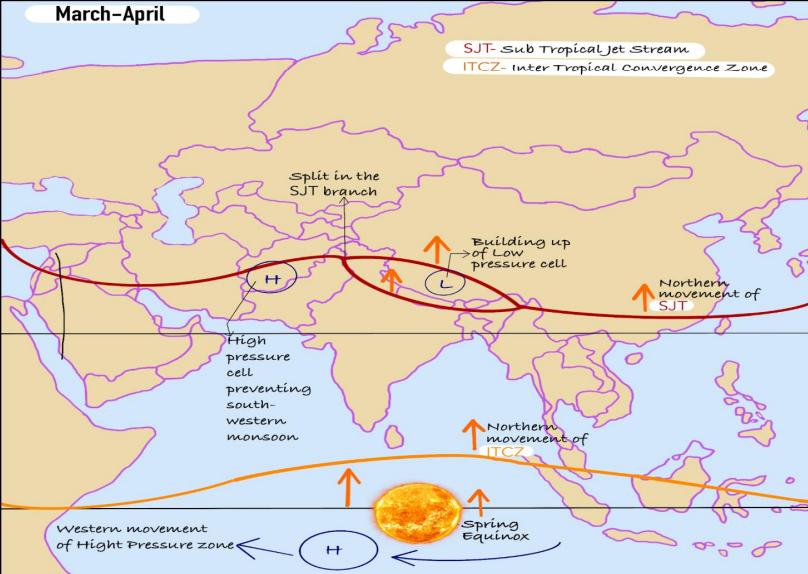
Summer Season in India – Key Aspects
| Aspect | Details |
|---|---|
| Duration | March – May |
| Temperature | Intense heating in plains; Tibet plateau warms strongly |
| Pressure | Low-pressure trough from Punjab → Bengal |
| ITCZ Movement | Moves northward towards Tropic of Cancer |
| Jet Streams | STJ splits into north & south branches |
| Impact | Pre-monsoon thunderstorms; sets stage for monsoon |
Mains Key Points
Prelims Strategy Tips
Indian Monsoon – Features, Theories & Dynamics
Indian Monsoon is a seasonal reversal of winds due to differential land-sea heating, ITCZ shift, jet streams, and Tibetan Plateau heating. It provides ~80% of annual rainfall in India. Its variability is influenced by ENSO, IOD, Madden-Julian Oscillation, and Western Disturbances.
Indian Monsoon is a seasonal reversal of winds due to differential land-sea heating, ITCZ shift, jet streams, and Tibetan Plateau heating. It provides ~80% of annual rainfall in India. Its variability is influenced by ENSO, IOD, Madden-Julian Oscillation, and Western Disturbances.
Key Monsoon Theories & Factors
| Theory/Factor | Key Idea | Impact |
|---|---|---|
| Thermal Theory (Halley, 1686) | Land-sea heating contrast | Explains reversal, not variability |
| Dynamic/ITCZ Theory | ITCZ shifts north | Draws SE trades → SW monsoon |
| Jet Stream Theory | STJ & Easterly Jet control | Affects onset, breaks |
| Tibetan Plateau | Heat low forms on plateau | Drives circulation |
| ENSO | Pacific warming/cooling | El Niño weakens, La Niña strengthens |
| IOD | Temp diff in Indian Ocean | Positive IOD strengthens monsoon |
| MJO | Intra-seasonal variability | Brings active/break phases |
Mains Key Points
Prelims Strategy Tips
Dynamic Concept of Monsoon (ITCZ / Air Mass Theory)
Propounded by H. Flohn (1951), the Dynamic or ITCZ Theory explains the Indian monsoon as a result of the seasonal migration of planetary winds and pressure belts, especially the Inter-Tropical Convergence Zone (ITCZ).
Propounded by H. Flohn (1951), the Dynamic or ITCZ Theory explains the Indian monsoon as a result of the seasonal migration of planetary winds and pressure belts, especially the Inter-Tropical Convergence Zone (ITCZ).
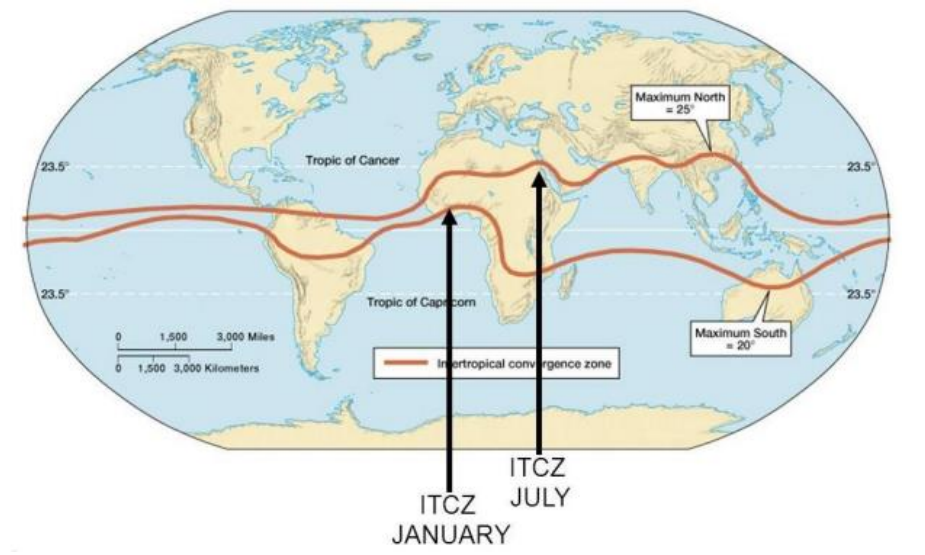
Comparison of Monsoon Theories
| Aspect | Halley’s Thermal Theory | Flohn’s Dynamic ITCZ Theory |
|---|---|---|
| Basis | Land-sea heating contrast | Seasonal shift of ITCZ & wind belts |
| Time | 1686 | 1951 |
| Scope | Local (India-focused) | Global (Africa, Australia, Latin America, India) |
| Wind Reversal | Explained as land-sea breeze | Due to ITCZ seasonal migration |
| Limitation | Fails to explain onset, breaks, variability | Better planetary explanation but lacks finer details |
Mains Key Points
Prelims Strategy Tips
Jet Streams and the Jet Stream Theory
Jet streams are fast-moving, narrow air currents in the upper troposphere (7.5–14 km), moving west to east due to strong temperature contrasts. They play a crucial role in global climate, aviation, and especially in the Indian monsoon system.
Jet streams are fast-moving, narrow air currents in the upper troposphere (7.5–14 km), moving west to east due to strong temperature contrasts. They play a crucial role in global climate, aviation, and especially in the Indian monsoon system.
Types of Jet Streams & Role in India
| Type | Location | Role in India |
|---|---|---|
| Polar Front Jet | 40°–60° latitudes | Steers western disturbances, winter rainfall in north India |
| Subtropical Westerly Jet (STJ) | 30°–35° latitudes | Controls winter climate; shifts north in summer → monsoon onset |
| Tropical Easterly Jet (TEJ) | Over India & Africa (summer) | Strengthens southwest monsoon rainfall |
| Polar Night Jet | Stratosphere ~30 km (winter) | Minimal impact on Indian climate, global circulation |
| Local Jets | Regional | Local storms, limited effect |
Mains Key Points
Prelims Strategy Tips
Impact of Jet Streams
Jet streams influence global and regional weather by controlling cyclones, anticyclones, storms, and monsoons. They also impact aviation efficiency and play a decisive role in the timing and strength of the Indian monsoon.
Jet streams influence global and regional weather by controlling cyclones, anticyclones, storms, and monsoons. They also impact aviation efficiency and play a decisive role in the timing and strength of the Indian monsoon.
Impacts of Jet Streams
| Aspect | Impact |
|---|---|
| Weather Systems | Intensify cyclones, anticyclones, and guide storm tracks |
| Aviation | Eastward flights faster; westward flights slower; wind shear risk |
| Indian Monsoon | STJ northward shift enables monsoon; TEJ strengthens it |
| Agriculture | Timely or delayed monsoon onset affects crop cycles |
Mains Key Points
Prelims Strategy Tips
Jet Stream Theory of Indian Monsoon
Jet Stream Theory explains how the shifting of the Subtropical Westerly Jet (STJ) and the emergence of the Tropical Easterly Jet (TEJ), aided by Tibetan Plateau heating and Somali Jet, determine the onset, strength, and variability of the Indian monsoon.
Jet Stream Theory explains how the shifting of the Subtropical Westerly Jet (STJ) and the emergence of the Tropical Easterly Jet (TEJ), aided by Tibetan Plateau heating and Somali Jet, determine the onset, strength, and variability of the Indian monsoon.
Jet Streams and Monsoon Linkages
| Jet Stream/Factor | Role in Monsoon |
|---|---|
| STJ (Subtropical Westerly Jet) | Northward shift → SW monsoon onset |
| TEJ (Tropical Easterly Jet) | Strength determines rainfall strength |
| Tibetan Plateau | Heat source creating low pressure → boosts TEJ |
| Somali Jet | Channels Arabian Sea moisture to India |
| El Niño | Weakens TEJ & Somali Jet → weak monsoon |
| La Niña | Strengthens TEJ & Somali Jet → good monsoon |
Mains Key Points
Prelims Strategy Tips
Monsoon in India
India experiences two monsoon systems: Southwest Monsoon (summer) and Northeast Monsoon (winter). The onset, progression, and withdrawal of monsoon are governed by ITCZ shifts, jet streams, Walker circulation, Mascarene High, and Coriolis force. Monsoon variability explains floods, droughts, and agricultural cycles in India.
India experiences two monsoon systems: Southwest Monsoon (summer) and Northeast Monsoon (winter). The onset, progression, and withdrawal of monsoon are governed by ITCZ shifts, jet streams, Walker circulation, Mascarene High, and Coriolis force. Monsoon variability explains floods, droughts, and agricultural cycles in India.
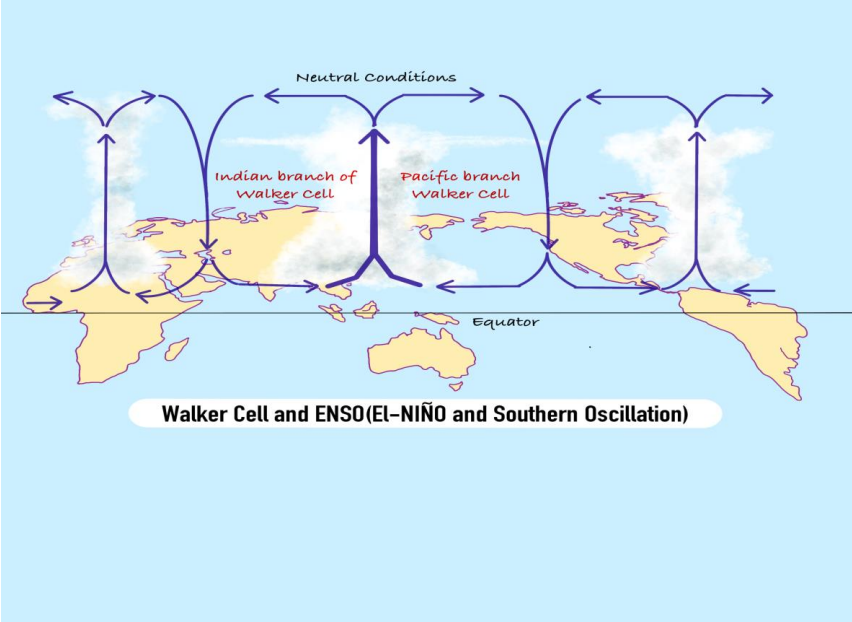
Phases of Indian Monsoon
| Phase | Features |
|---|---|
| Onset | ITCZ shift, STJ moves north, Kerala gets first rains (June 1) |
| Progression | Covers whole India by mid-July; Arabian & Bay branches spread rains |
| Break Monsoon | Temporary pause; rains confined to foothills |
| Withdrawal | Begins Rajasthan (Sept), completes by Oct |
| Northeast Monsoon | Oct–Dec; affects TN, AP, SE Karnataka, Kerala |
Mains Key Points
Prelims Strategy Tips
Burst of Monsoon and Bay of Bengal Branch
The sudden increase in rainfall at the onset of the monsoon is called the 'burst' of the monsoon. The Bay of Bengal branch of the Southwest Monsoon plays a key role in rainfall over eastern and northern India, splitting into sub-branches that influence Bengal, Assam, the Brahmaputra valley, and even Punjab.
The sudden increase in rainfall at the onset of the monsoon is called the 'burst' of the monsoon. The Bay of Bengal branch of the Southwest Monsoon plays a key role in rainfall over eastern and northern India, splitting into sub-branches that influence Bengal, Assam, the Brahmaputra valley, and even Punjab.
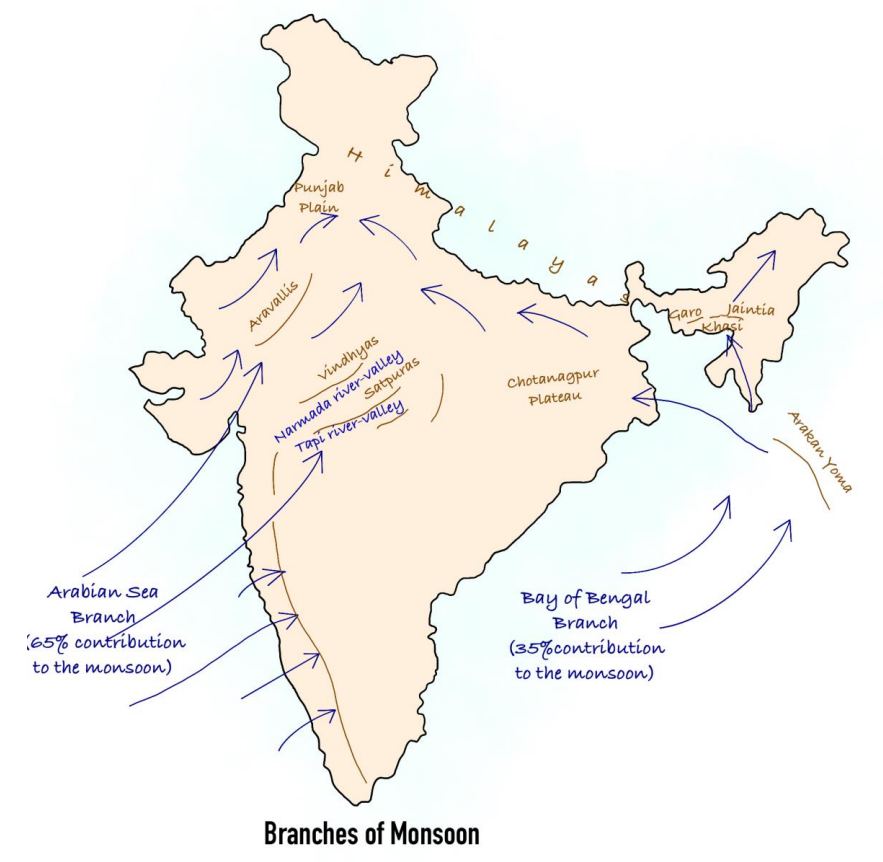
Bay of Bengal Branch – Key Features
| Branch | Impact |
|---|---|
| Myanmar Branch | Heavy rains over Arakan & Tenasserim ranges |
| West Bengal & Bangladesh | Deflected by Himalayas; monsoon enters India |
| Ganga Plains Branch | Rainfall from Bengal to Punjab |
| Brahmaputra Valley Branch | Heavy rains in Assam & Meghalaya |
| Khasi Hills | Mawsynram – highest average rainfall in world |
Mains Key Points
Prelims Strategy Tips
Arabian Sea Branch of Southwest Monsoon
The Arabian Sea branch of the Southwest Monsoon splits into three sub-branches. It causes heavy orographic rainfall along the Western Ghats, contributes to central India rains through the Narmada–Tapi valleys, and brings limited rainfall to Saurashtra, Kachchh, and Rajasthan. It eventually merges with the Bay of Bengal branch near Chhotanagpur Plateau and Punjab.
The Arabian Sea branch of the Southwest Monsoon splits into three sub-branches. It causes heavy orographic rainfall along the Western Ghats, contributes to central India rains through the Narmada–Tapi valleys, and brings limited rainfall to Saurashtra, Kachchh, and Rajasthan. It eventually merges with the Bay of Bengal branch near Chhotanagpur Plateau and Punjab.
Sub-Branches of Arabian Sea Monsoon
| Branch | Region | Impact |
|---|---|---|
| Western Ghats Branch | Kerala, Karnataka, Konkan–Goa | Orographic rainfall (250–400 cm); rain-shadow east |
| Narmada–Tapi Valley Branch | Madhya Pradesh, Central India | Widespread central India rainfall; merges with Bay branch |
| Saurashtra–Kachchh Branch | Gujarat, Rajasthan | Very little rainfall; moves along Aravalis; joins Bay branch |
Mains Key Points
Prelims Strategy Tips
Break in Monsoon and Retreating/Northeast Monsoon
The Indian Monsoon shows interruptions (‘breaks’) when rainfall weakens in July–August, and a withdrawal phase (‘retreating monsoon’) beginning in September. This retreat transitions into the Northeast Monsoon (Oct–Dec), vital for rain-shadow regions like Tamil Nadu. The variability of these phases has deep agricultural, ecological, and economic significance.
The Indian Monsoon shows interruptions (‘breaks’) when rainfall weakens in July–August, and a withdrawal phase (‘retreating monsoon’) beginning in September. This retreat transitions into the Northeast Monsoon (Oct–Dec), vital for rain-shadow regions like Tamil Nadu. The variability of these phases has deep agricultural, ecological, and economic significance.
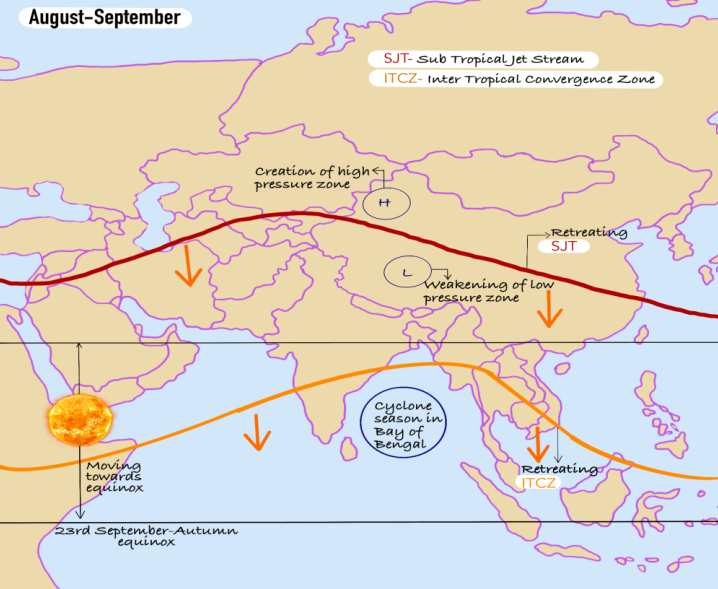
Monsoon Phases in India
| Phase | Period | Rainfall Pattern | Regions Affected |
|---|---|---|---|
| Southwest Monsoon Active | June–Sept | Heavy, widespread | All India (esp. Western Ghats, NE, Ganga plains) |
| Break in Monsoon | July–Aug (5–10 days) | Rain ceases in plains, heavy in Himalayas | NW & Central India dry; Himalayas wet |
| Retreating Monsoon | Sept–Oct | Declining rains | NW India → Central → Deccan |
| Northeast Monsoon | Oct–Dec | Heavy coastal rains, cyclones | Tamil Nadu, Andhra, Odisha, SE Karnataka, Sri Lanka |
Mains Key Points
Prelims Strategy Tips
Distribution of Rainfall in India
India’s average annual rainfall is ~125 cm, but its distribution is highly uneven. The Western Ghats’ windward slopes and Northeast hills get extremely high rainfall, while Rajasthan, Ladakh, and parts of the Deccan plateau remain arid or semi-arid.
India’s average annual rainfall is ~125 cm, but its distribution is highly uneven. The Western Ghats’ windward slopes and Northeast hills get extremely high rainfall, while Rajasthan, Ladakh, and parts of the Deccan plateau remain arid or semi-arid.
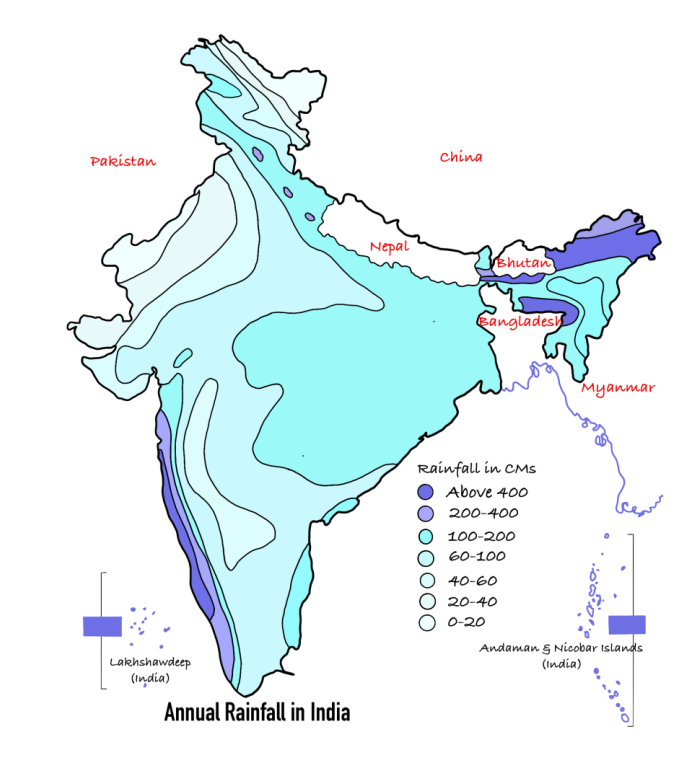
Distribution of Rainfall in India – Regional Patterns
| Category | Rainfall (cm) | Regions |
|---|---|---|
| High Rainfall | >200 | Western Ghats (windward), Assam, Meghalaya, Arunachal Pradesh, NE West Bengal |
| Medium Rainfall | 100–200 | Eastern slopes of Western Ghats, Odisha, Bihar, Jharkhand, TN, MP (east) |
| Low Rainfall | 50–100 | Western MP, Maharashtra (rain-shadow), Eastern Rajasthan, Punjab, Haryana, UP |
| Inadequate Rainfall | <50 | Thar Desert, Ladakh, Kutch, Rayalaseema (AP), Interior Karnataka |
Mains Key Points
Prelims Strategy Tips
Cloud Seeding
Cloud seeding is an artificial weather modification technology that enhances rainfall by dispersing chemical nuclei (like silver iodide, dry ice, or salts) into clouds, accelerating condensation and precipitation. It only works when sufficient clouds exist.
Cloud seeding is an artificial weather modification technology that enhances rainfall by dispersing chemical nuclei (like silver iodide, dry ice, or salts) into clouds, accelerating condensation and precipitation. It only works when sufficient clouds exist.
Cloud Seeding – Key Methods
| Method | Description | Outcome |
|---|---|---|
| Hygroscopic | Salts dispersed in lower clouds via flares/explosives | Salt particles attract moisture → rainfall |
| Static | Silver iodide crystals spread into clouds | Nuclei for condensation → rainfall droplets form |
| Dynamic | Boosts vertical air currents in clouds | Enhances cloud moisture movement → more rain |
Mains Key Points
Prelims Strategy Tips
Chapter Complete!
Ready to move to the next chapter?
